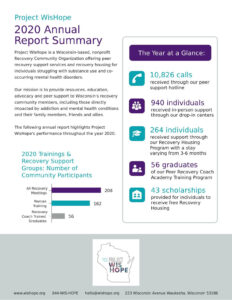Narcan Training
Narcan Training at Project WisHope
Project WisHope is offering a free, life-saving Narcan (Naloxone) Training for Wisconsin’s recovery community members, including individuals who are struggling with opioid addiction and their family members, friends and allies. The purpose of this training is to help you know what to do if someone overdosed and how you can help.
In Wisconsin, an estimated 78% of drug overdose deaths involved opioids in 2018 totaling more than 846 (a rate of 15.3). And in 2018, Wisconsin providers wrote 45.8 opioid prescriptions for every 100 persons compared to the average U.S. rate of 51.4. With this in mind, it’s helpful to know how to administer Narcan, which is a nasal spray that restores breathing that has been dangerously slowed by an opioid overdose. When administered correctly, Narcan can work within a minute or two, giving emergency responders time to get the person to a hospital.

Participants of this free Narcan training will:
Learn how to administer Narcan correctly, which can ultimately save lives
Receive a free Narcan kit.
How does Narcan work?
Naloxone is a life-saving drug that can revive overdose victims by blocking or reversing the effects of opioid medication, including extreme drowsiness, slowed breathing, or loss of consciousness. Narcan (for use in the nose) is used to treat a narcotic overdose in an emergency situation. Naloxone (Narcan) helps restore breathing to a person who is overdosing from opioid drugs such as heroin and prescription drugs such as oxycontin, oxycodone and fentanyl. It also is used to reverse the effects of narcotic drugs used during surgery and to treat pain.
What are the signs and risks of opioid overdose?
A person who has overdosed before is more likely to overdose again. However, their self-perception of risk decreases quickly.
Signs of an opioid overdose include:
- The person cannot be woken up
- Slow or no breathing
- Gurgling, gasping or snoring
- Clammy, cool skin
- Blue/grey lips or nails
The following factors increase the risk of an opioid overdose:
- Resuming opioid use after a break (i.e., while in jail, hospital, detox or treatment) when tolerance has dropped
- Using opioids with other drugs like stimulants (cocaine or methamphetamine), depressants like benzodiazepines (Vailum®, Xanax®) or alcohol, or with additional opioids
- Taking opioid medications more often or in higher doses than prescribed
- Using alone also increases the chances a person will die from an overdose
- Using someone else’s opioid medications
- Unknown strength or contents of heroin or other opioids bought on the street
- Any current or chronic illness that reduces heart or lung function
Narcan Training Dates:
Please check our event calendar to see when our next Narcan training will be. If you’d like us to bring our Narcan training to your facility, please contact us at hello@wishope.org or sign up using the button below.

